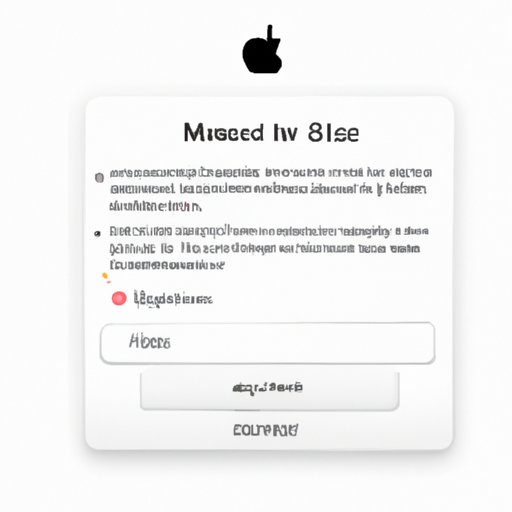I. Introduction
Welcome to our comprehensive guide on how to factory reset iMac. If you’re experiencing issues with your computer, a factory reset can often solve the problem. In this article, we’ll guide you through the steps to do a factory reset, as well as cover common issues that can be fixed through a reset. Whether you’re a beginner or an advanced user, we’ve got you covered. So, let’s get started!
II. Step-by-Step Guide to Factory Reset iMac
Before we begin, it’s important to note that factory resetting your iMac will erase all data on your computer. Thus, make sure that you have backed up all of your important data before you begin.
Step 1: Back up important data
There are many ways to back up your important data on iMac. You can use Apple’s built-in Time Machine feature to create a complete backup of your computer, or you can back up individual files and folders using iCloud or an external hard drive. Once your data is completely backed up, you’re ready to proceed with the factory reset.
Step 2: Sign out of iCloud
Before beginning the reset process, it’s important to sign out of iCloud. This will remove your device from Find My Mac service and avoid any complications when selling or giving away your device. To do this, go to Apple Menu > System Preferences > iCloud, and then click on “Sign Out”.
Step 3: Erase the hard drive
Once you’ve backed up your data and signed out of iCloud, you’re ready to erase the hard drive. To do this, reboot your iMac, and hold down Command + R at startup until the Apple logo appears. This will launch macOS Recovery mode. Click on “Disk Utility” and select the hard drive that you want to erase. Click on “Erase” and select “macOS Extended (Journaled)” as the format type. Finally, click on “Erase” again to confirm.
Step 4: Reinstall macOS
After erasing the hard drive, you’ll need to reinstall macOS. From macOS Recovery, select “Reinstall macOS” and follow the on-screen instructions to complete the installation. This process may take a while, depending on your internet speed. After the installation is complete, your iMac will restart automatically.
Step 5: Set up the iMac
After the restart, the iMac will display the initial setup screen. Follow the on-screen instructions to set up your iMac. Once you’ve completed the setup process, you’ll have a fresh version of macOS installed on your iMac.
III. Common Issues That Can Be Fixed by Factory Resetting iMac
Factory resetting isn’t just for when your computer is completely broken. There are many common issues that can be fixed by a reset, including:
- Slow performance
- Software glitches or errors
- Inability to update software or install new programs
- Network connectivity issues
- Corrupted system files
If your iMac has any of these issues, a factory reset may be the perfect solution. It will wipe out any problems that may be associated with the software, but it will also erase all of your data. Thus, it is important to try other methods of troubleshooting before deciding to reset your iMac.
IV. Video Tutorial for Factory Resetting iMac
If you’re a visual learner, a video tutorial can be a great way to learn how to do a factory reset. Below is a quick and easy video tutorial for resetting your iMac to its factory settings.
V. Quick Tips for Efficiently Factory Reset iMac
Here are some quick tips to help you efficiently factory reset your iMac:
- Use keyboard shortcuts to speed up the process. For example, press Command + R at start-up to boot into macOS Recovery mode.
- Make sure you have everything you need before you start the reset. This includes a backup of your data, the name and password of your Wi-Fi network, and your Apple ID and password.
- Be patient. The factory reset process can take some time, especially if you need to reinstall macOS.
- Ensure you have a stable internet connection before reinstalling macOS. This will ensure that the process isn’t interrupted during the download.
VI. Alternative Options for Factory Resetting iMac
If you’re not comfortable with factory resetting your iMac yourself, or if you’re experiencing issues that a factory reset can’t fix, there are third-party software options available. These options can take a more targeted approach to troubleshooting and are generally easier to use than the manual reset method above.
One of the most popular options is CleanMyMac X. This is an all-in-one cleaning and optimization tool for your Mac. It can be used to remove junk files, speed up your computer, and keep it running smoothly. Follow the steps below to reset your iMac using CleanMyMac X:
- Download and install CleanMyMac X.
- Open the app and go to the Uninstaller tab.
- Select “Full Disk Access”
- Click on “View Uninstaller” and follow the on-screen instructions to complete the uninstallation process.
- Restart your computer and open the app again.
- Click on the “Maintenance” tab, and then select “Script” in the left panel.
- Select “Factory Reset” and follow the on-screen instructions to complete the reset process.
CleanMyMac X is not a free app, and comes with a yearly subscription-based pricing plan. It also offers a wide range of features such as malware removal, space optimization, and real-time system monitoring and alerts.
VII. Conclusion
We hope this guide has been helpful in understanding how to factory reset your iMac with ease. Remember, a factory reset is a powerful tool that can not only fix common issues but also wipe away all data on your computer. So, make sure you have properly backed up all of your important data before proceeding. If you still have questions or concerns, feel free to reach out to Apple support or a professional computer technician.
